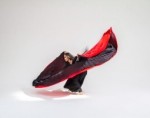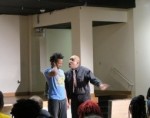
David Brick, Quixotic Ringmaster of a Quiet Circus
by Jenna Horton
David Brick, co-director of Headlong, is deep in investigation mode for his upcoming project, The Quiet Circus, which will debut later this year on the Washington Avenue Green—a pier where Washington Ave. meets the Delaware River, where industrial meets retail, where rotted wood and plastic trash meet reclaimed greenspace.
Amidst this landscape, several pieces— including performances and installations—will unfold with the aim of activating questions around performer and audience perception of time in relation to performance, as well as inviting an ongoing relationship with a rapidly changing, unstable urban landscape.
A deflated bouncy ball, cinder blocks (some fake, some real), a thick weathered rope, and nine tractor tines. For the past year, this pile of objects has moved in various configurations through Headlong offices. I sat down with David to ask, “what’s going on here?”
1. Landscape, the tractor tines game
David Brick bowling-balls in. He carries a plastic crate with nine rusty tractor tines.
The clang-clang-bang-bang of the tines mimic David’s clang-clang-bang-bang through the room. He hands me a sheet of paper titled “The Rules of Attention.” I glance over them while he plugs in a string of Christmas lights to the wall, bunches them up on the floor, talks at me about many things which I largely miss. He runs to turn off the overhead lights, futzes with them a bit, and says, “maybe we could do this first?” I don’t even know what this is yet.
A signature energetic state of David’s—to bowling-ball. He hurls energy from place to place. David, you see, refuses time as dictator. It seems he considers the markers 8:15 a.m. or 6:45 p.m. arbitrary delineations for when something should and shouldn’t be going on. Of course, he doesn’t escape it, those markers, but he does try. As such, he often inhabits one of two states: catching up or holding off.
In this instance, David momentarily holds time at the door. The interview doesn’t start here. Instead, a new focus blooms around us.
We breathe. We consider the tines. We take turns placing them in the space. We do not talk. Among other things, David requested that I pay attention to the need to make something interesting happen, but not necessarily to follow its demands. And also, NOT TO WORRY ABOUT TIME. Tactile in their weight, ferrous in quality, structural in their curvature: the tines are so satisfying.
David found these nine tractor tines in the woods near Allentown on a self-guided meditation retreat during the winter as meditating started to become a more intimate and regular practice in his life. He instantly started pulling them out of the earth and playing with them. He took them back to his South Philadelphia living room, where, with time, many dinner guests, and trial and error, he devised a sort of parlor game—the ‘game’ we’re playing now AND the task he’s given performers to do over and over in rehearsals and performance.
This game will be one of the installations in The Quiet Circus, allowing audience members to engage with the landscape (the pier instead of the studio), nine objects (designed and found, instead of tractor tines), and themselves within that constellation. The players will arrange the nine objects in the space, and then will place themselves amidst the landscape they’ve helped create. Photos of these last moves will accumulate over the course of the installation.
2. Island, a proscenium-oriented performance about time.
JH: Other than the tractor tines, where did your interest in performance time start?
DB: I began to feel like, as a choreographer or director, we get good at this thing about performance time—of knowing when something should happen, that is, a surprise or the right amount of time … and I began to be very suspicious about that. So much of making things work seemed to be just about that. (Laughs.) I remember it kinda doesn’t matter what you’re doing, if you get the rhythm right. Everything’s fine. The audience will be totally interested. It’s a clever thing to say or to notice, but there’s something really sad about what that means about content.
And I began to wonder about that rhythm itself. More and more, in my kind of over-determined, politically hyperbolic way, I was like, that’s the rhythm of consumerism! That’s the rhythm of capitalism! (Laughs.) And I started calling it, I want, I get. So, like, you know, I see something. I’m interested for a short period of time before I want (snaps) something else, right, cuz I got it, okay (claps), what else? And I was like, that’s so sinister…. I began to think of it like the rhythm of curiosity versus the rhythm of desire. And these are shorthand. I don’t mean for them to be profound ideological statements.
JH: So you’re saying you experience a problem with depth of content in time-based performance? Can you elaborate?
DB: The essential thing about time in time-based performance is it’s moving and you can’t slow it down. You can’t stop it. You can’t rewind it. You can’t think about something else and then come back to it. It goes … it keeps going … it keeps disappearing. So you can’t engage in performance on your own cognitive rhythm … and as a maker, people either get it or they don’t…. That’s one problem with depth in time based performance.
JH: The conveyor belt of time.
DB: Yeah.
JH: So, what’s the other problem?
DB: Groupthink. An audience watches everything as a group. I’ve made a lot of pieces for one person at a time and the very first thing I noticed was that there’s something fundamentally different about the way we talk to ourselves when we’re the only one watching something … the way I read a book or look at a painting or read a poem for myself. My own idiosyncratic wanderings and associations bubble up as I interpret what I’m watching and it feels totally fine. But the minute I’m in a group, the social world becomes, “this is for a we and what do we think about it?”
The Quiet Circus will include a staged performance in proscenium, giving David, performers, and audience an opportunity to wrestle with and experience these ‘problems’—not so much problems in a negative sense, but, rather, distinct structural characteristics—within the container of live performance.
3. In the Suitpod Doing Nothing, an installation
JB: Name three things that are luminous to you.
DB:
1) My daughter, Zephyr Saffron Matsushima Brick.* Glowing at all times.
2) Avocados at H-mart, which is a Korean grocery chain in the United States.
3) A provocation I received from a meditation teacher to do nothing. Which doesn’t mean to meditate. It means do nothing.
I remember being six years old and waking up. It’s a Saturday morning. And I’m hearing the noise of the kids playing outside. And in my family, I’m the interpreter because my family’s deaf ... so when I’m awake and the family is up, I’m on, ready to answer the phone or the door, to be of use as an interpreter. So this is before anyone knows I’m awake, and I don’t have any role to play, and I remember just kind of lying in bed and doing nothing, my mind drifting and I was like, “okay, that’s my model for doing nothing.” It’s been an extremely useful provocation.
Certain aspects of The Quiet Circus evolve from an installation David created called an Attention Suitpod—an enclosed space-alien-looking thing just a bit bigger than your body with a visor of one-way glass which you can look through from the inside. It is an invitation to see the world as it is, without fantasy, without projection. You can read more about it here. Audience members sit in there for four minutes and thirty-three seconds, in honor of John Cage’s 1952 composition 4’33.
4. The Luminous World, a subliminal, and maybe even invisible performance
JH: So then there’s this other thing….
DB: I’m not sure I should even talk about it.
The Quiet Circus will likely begin in September of 2016, and will be completed over the course of a year and a half, with thirty-six performances in total.
* The Home Page image is of Saffie sitting on a steel slab that is part of a work at the Lee Ufan Museum designed by Tadao Ando on the Japanese Inland sea island of Naoshima in 2012.
By Jenna Horton
April 27, 2016







